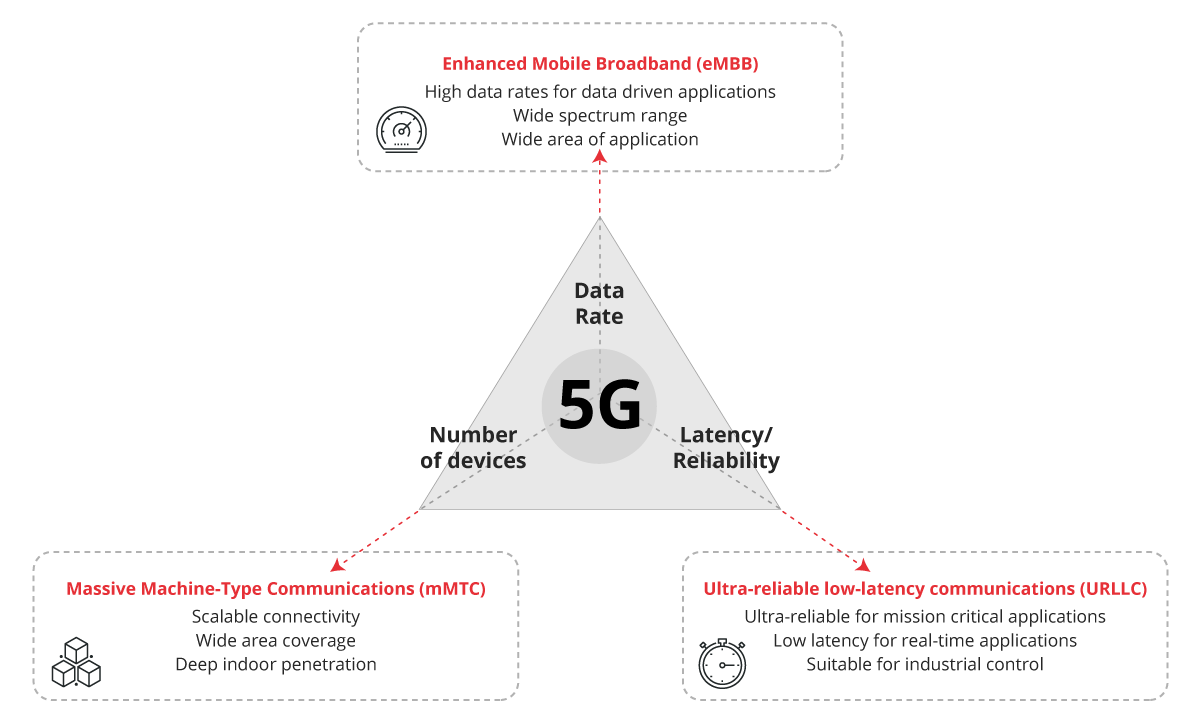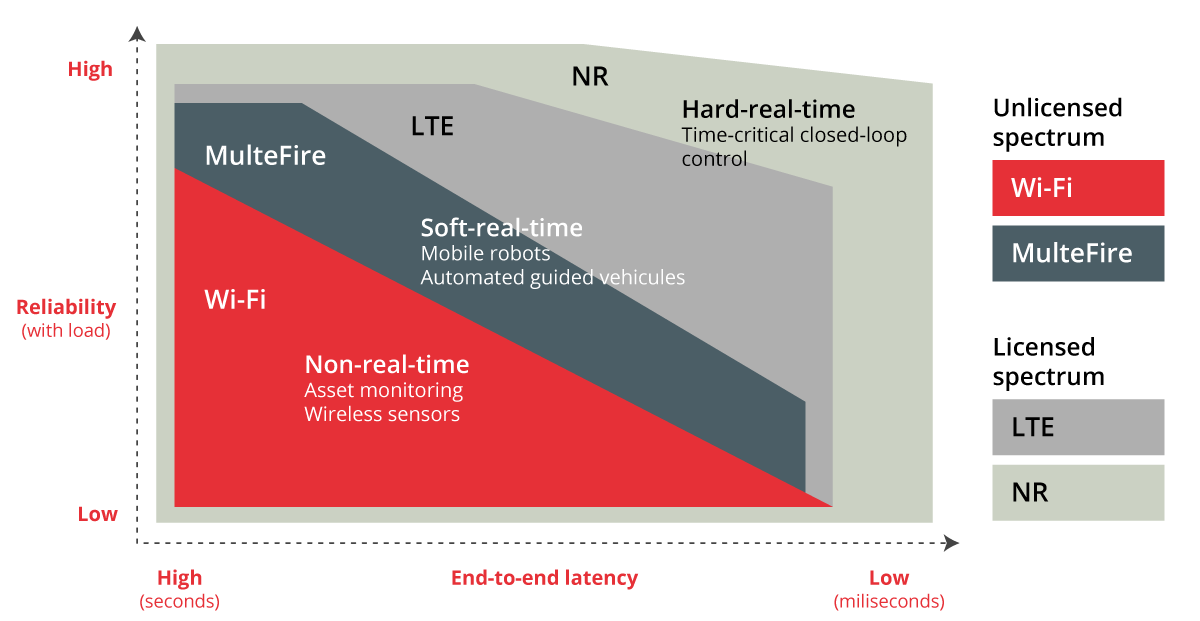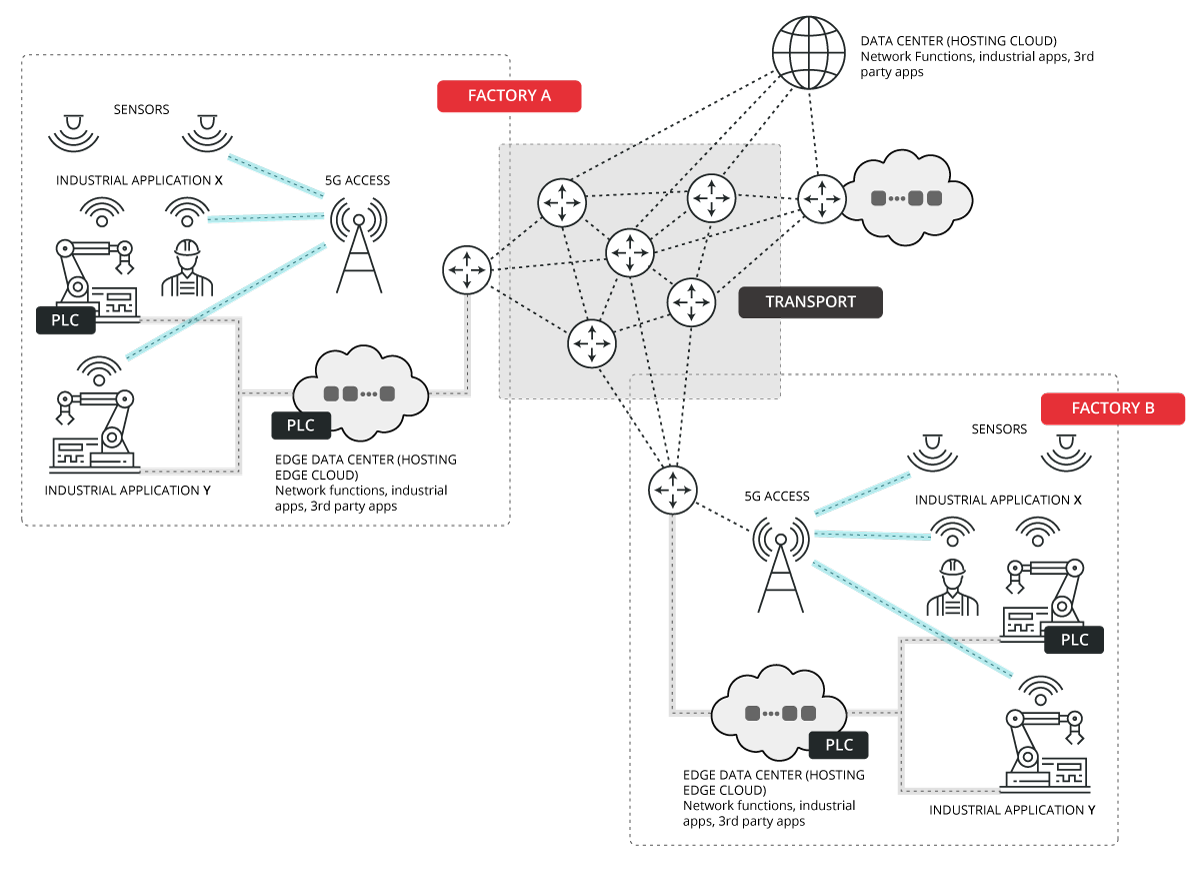5G for the new connected industry

The enormous success of wireless technologies in consumer electronics means that they are becoming increasingly more relevant in the industrial world. Concepts such as the Industrial Internet of Things (IIoT) have driven the industrial applications where wireless communications are widely used within the production system. Technologies such as WiFi, Trusted Wireless, Bluetooth, Zigbee or WirelessHART are beginning to be consolidated in the industry.
In wired environments, time and network reliability are ensured for field devices. Nonetheless, when wireless technologies are introduced, ensuring these requirements is much more complicated due to the setbacks of the propagation medium. In fact, the currently deployed wireless solutions (typically WLAN using an unlicensed band) make up only a small piece of the productive set and mainly play the role of connecting sensors for which the communication requirements are not critical.
Therefore, this article presents a wireless technology that meets said requirements and that could definitively boost the growth of industry 4.0: 5G.
¿What is 5G technology?
5G commonly refers to the 5th generation of the technology used in mobile communications; therefore, it is not a new term per se, but rather a direct evolution from the current 4G/LTE:
Designed to provide greater user capacity, greater transmission speeds and a much lower network latency compared to its predecessors, its great reliability will enable the creation of new innovative services throughout the different industry sectors.
There are numerous benefits provided by 5G:
- Greater speeds. The use of 5G means an increase of the transmission speed up to 100 times faster than its predecessor.
- Lower latency. This technology will involve a significant reduction of the latency compared to its predecessor. Normally with 4G some 40-50 milliseconds are obtained, while with 5G 1 millisecond, or even less, will be obtained.
- Greater capacity. 5G will have much more capacity, meaning that it will be able to support more devices connected at the same time.
- Reliability. This technology is expected to be very reliable, which would enable its use for critical applications such as remote-control surgeries or process control.
- Flexibility. 5G will make it possible to divide a physical network into multiple logical networks where the operator may use the most convenient one, depending on the application.
- Efficiency. It is said that 5G is the technology that will finally boost the Internet of Things (IoT). This is reinforced by this technology’s energy efficiency, which will allow for its use in small and isolated devices.
5G applied to ICS
One of the main differences between 5G and previous generations lies in the strong focus on machine-type communication and the Internet of Things (IoT). Furthermore, it has the potential to provide wireless connection for a wide range of different industrial applications. Long-term, it is expected to enable the convergence of the different communication technologies used at present, thus reducing the number of relevant industrial connectivity solutions, such as those mentioned earlier.

- The 3 most important characteristics of 5G. Source: Siemens -
Its most interesting areas of application may range from logistics and inventory, robotics and motion control applications to control and location operations for devices and pieces.
The industrial world has specific 5G requirements that differ significantly from mobile broadband (MBB) services. These include:
- URLLC (Ultra-reliable low-latency communication). In order to comply with the latency and reliability requirements of industrial processes, 5G NR (New Radio), in its 16th review, seeks to achieve this goal, promising up to 99.9999% reliability and latency of about 0.5 - 1 millisecond. To comply with the availability and latency requirements, the fastest and most optimized multi-antenna and package planning techniques, shorter and more robust transmissions, as well as faster repetitions and broadcasts, among others.
- Licensed spectrum for interference control. The availability of the spectrum resources used for communications is key in order to achieve the capacity, transmission speed and latency requirements. Therefore, in order to provide plant-level predictable, deterministic, and reliable service levels, the spectrum resources should be carefully managed. For critical applications, there should be guarantees against possible uncontrolled interference, which means the use of a licensed spectrum.

- Aspects of latency and reliability in the choice of spectrum and technology. Source: Ericsson -
As shown in the figure above, wireless technologies that use an unlicensed spectrum band, like WiFi or MultiFire, are unable to guarantee a controlled low latency with high reliability with increasing load. However, it’s feasible to use them in less critical applications, just as they have been used to date.
- Integration with industrial Ethernet and TSN (Time-Sensitive Networking). 5G allows for it inclusion in production chains to be gradual, beginning in those areas where its use is more advantageous. Over time, more devices will be integrated with 5G a new capabilities are introduced in the future. However, some parts of the production line could not have a great need for wireless connection, therefore there will be 5G networks that require integration with wired LAN networks. Given that Ethernet traffic is needed, version 15 of the standard 5G NR included this capability. Furthermore, as part of the current industrial transformation, the wired communication of the industrial networks is progressing towards a common standard: Ethernet with support for TSN, extension of the standard IEEE 802.3 that makes it possible to provide a deterministic latency without congestion losses for priority traffic on an Ethernet network where lower priority traffic is also transported. The version 16 of the standard 5G NR also include this capability.
- Keep the system on the premises. Many companies from the industrial world require complete control over the communications of their most critical OT systems (in other words, independent of third parties), in order to comply with the availability requirements. 5G enables compliance with these requirements, keeping the monitoring and management of the communication solution, as well as the data related to production, within the installations, whether for security or availability reasons. Similarly, it guarantees the availability of the connectivity solution regardless of the outside factors that may occur.
- Security improvements. Mobile network security has been maturing with each generation, enabling confidential communication services, user privacy, user authentication for network access and authentication on the network, in such a way that the users know that they are connected to a legitimate network. In order to address new use cases and the constant evolution of threats, 5G includes new security features that benefit the industrial implementations. These include:
- Improvements in the confidentiality of the user plane, achieved by encrypting the communications by means of the 5G system.
- Authentication of devices through the use of SIM or a certificate.
- Prevention of attacks on the IMSI (International Mobile Subscriber Identity), since the identifier code is never transmitted through the network in plain text.
- Virtual segmentation capabilities of one physical 5G network. This would make it possible to isolate distinct security areas according to their degree of severity, a prerequisite in the OT domain.
- Private 5G networks. The technology behind mobile networks is almost always deployed and operated by a licensed and public operator. Private networks powered by 5G are a major change to this structure. Regarding the physical deployment, the term private network refers the networks with company-specific core, radio and transmission equipment, which are, therefore, under its control. This generally means that the equipment will be deployed in the client’s installations, regardless of who undertakes its daily maintenance. Having dedicated equipment is really important for OT production systems, given that possible power outages, degradation of the service or security incidents could have a very high economic impact for the owner and, in some cases, personal safety. There are two basic methods of 5G networks that are expected to be adopted in the market: private networks that don’t depend on a licensed public operator and private networks integrated in public networks.
- Other features of interest, that could be of use in various use cases in the industrial world are:
- Positioning: included in version 16 of the standard and aims to achieve indoor positioning with an accuracy of less than 3 meters.
- Time synchronization between devices: also, in version 16, it is a new requirement, whereby 5G will be able to sync the devices with a master clock of one or more-time domains. One reason for this is that various industrial applications require time-synchronized applications in multiple machines. The standard will allow a base station to provide an accurate time reference to the devices with a precision under a microsecond. This capability is directly related with the integration of 5G with TSN.

- Diagram of industry connected with 5G. Source: 5G-ACIA -
Conclusion
As we have seen in this article, 5G seems to be the chosen technology to finally make the purest definition of industry 4.0. The numerous capabilities it has make it a good fit for this job: very low latencies, virtual segmentation of networks, precise positioning or integration with industrial protocols, among others. However, not all of these are advantages. The technical difficulty arising from its development has increased the cost of rolling out this technology. Besides that, it’s necessary to have a compatible device, the previous ones being outdated. Despite Spain being one of the pioneering countries in the implementation of 5G applied to mobile broad band, deployed in its NSA (Non-Stand-Alone) version. In other words, 4G is still needed to function, so there are still two or three more years until we’ll finally be able to see it at its best and with all the capabilities.









